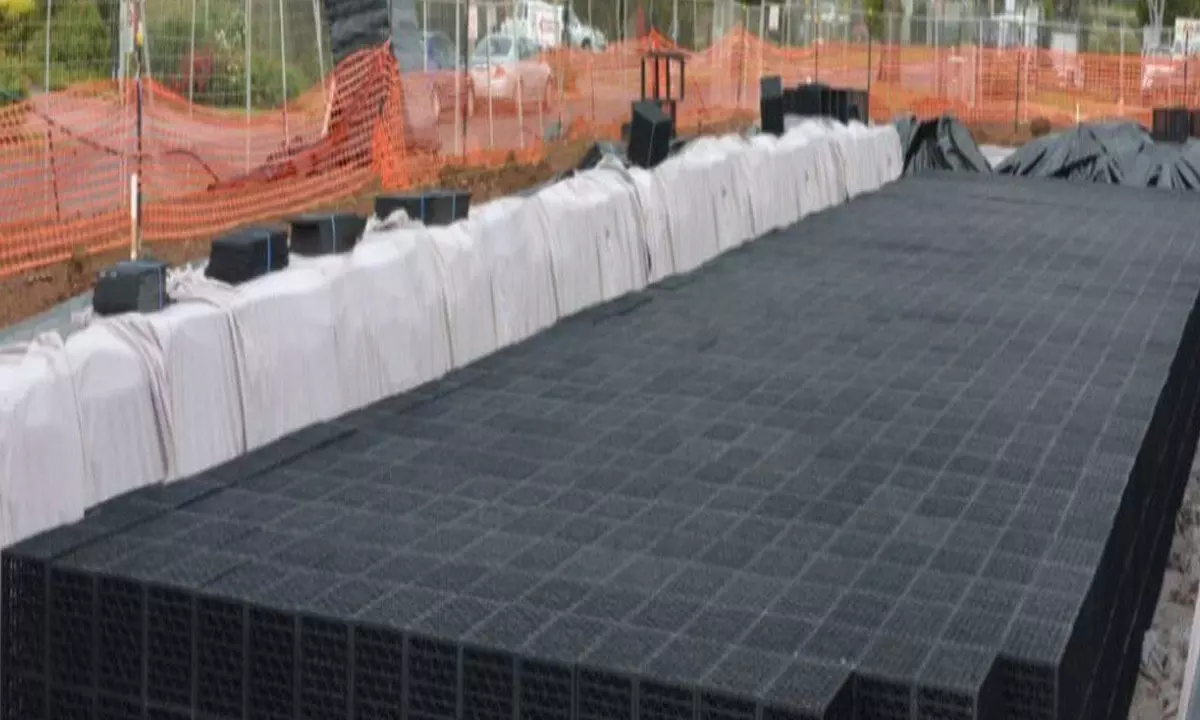Live
- They always want me to win, and now I feel lucky to have been offered a story like ‘Zebra’: Satyadev Kancharana
- ‘Democracy first, humanity first’: PM Modi in Guyana's parliament on two countries' similarities
- PKL Season 11: Telugu Titans register third straight win to top standings
- Is Pollution Contributing to Your COPD?
- NASA Unveils Underwater Robots for Exploring Jupiter's Moons
- Additional Central forces arrive in violence-hit Manipur
- AR Rahman and Saira Banu’s Divorce: Legal Insights into Common Issues in Bollywood Marriages
- 82.7 pc work completed in HPCL Rajasthan Refinery area: official
- Curfew relaxation extended in 5 Manipur districts on Friday
- Tab scam prompts Bengal govt to adopt caution over fund disbursement
Just In
Hyderabad: Opting modular harvesting system aneffective solution to stormwater issues


- The system is designed to capture the stormwater at the source
- The natural filtration with additional sand and geotextile filtration ensures the quality of stormwater
- Provides an effective solution for storm water logging
- The modules made out of high-end polypropylene are stacked and arranged on site
- The earth is excavated, and the channels are filled with a layer of stone chips and sand
- The earth is excavated, and the channels are filled with a layer of stone chips and sand
- A layer of sand is filled and back filled with the help of soil
Hyderabad: In times of heavy rainfall, roads often face severe flooding due to the excessive accumulation of water. To effectively tackle this issue, one of the most promising solutions is to prioritise the implementation of a modular rainwater harvesting approach.
When there is a substantial amount of rainfall, the natural drainage systems in urban areas can become overwhelmed, leading to excessive water runoff on roads and other impervious surfaces. This phenomenon, known as urban flooding, not only disrupts transportation but also poses risks to property and public safety.
The modular rainwater harvesting system is ingeniously designed to tackle stormwater issues at their source. By strategically placing modular units along roadsides, park peripheries, and even under metro bridges, this system efficiently captures rainwater during heavy downpour. The captured stormwater undergoes a natural filtration process aided by sand and geotextile filtration, ensuring that pollutants and contaminants are effectively removed, resulting in high-quality stormwater. This versatile approach finds applications in various urban settings, including road sidewalks, road dividers, park peripheries, and trenches under metro bridges, making it a highly effective solution to combat stormwater logging and promote sustainable urban development.
Speaking to The Hans India, Kalpana Ramesh, Founder, Rain Water Project says, “In contrast to the traditional rainwater harvesting pits located on rooftops or green spaces, the modular rainwater harvesting pits offer a remarkable advantage – they demand minimal maintenance and can serve effectively for a remarkable period of 20 to 25 years.
This innovative approach not only aids in preserving water but also presents an opportunity to significantly enhance groundwater resources. Deploying these modular systems, particularly beneath flyovers, becomes a strategic move as we not only conserve water but also transform these spaces into lush green areas. Many European cities have embraced this progressive method, earning widespread support and admiration from the public for its sustainable and transformative impact.”
At the first stage, the modular setup incorporates a plastic filtering mechanism on top to arrest debris and plastic waste, preventing them from contaminating the collected rainwater. Subsequently, the stormwater undergoes purification via sand filtration, removing impurities and sediments that may have been accumulated during the rainfall. This initial filtration process helps in rendering the rainwater relatively clean and suitable for various non-potable uses.
The geotextile utilised in the modular systems can prevent mud from entering the collected water; however, sewage water requires a more advanced secondary and tertiary filtration and treatment process to become reusable. The existing modular design, although effective for rainwater and stormwater, falls short in treating sewage water adequately.
By positioning these moduvlar units in gravity-based configurations, the harvested water gains the advantage of natural flow, enabling it to be conveyed to ponds, injection bore wells, and lakes. This gravity-assisted transportation reduces the need for energy-intensive pumps, making the process more environmentally friendly and cost-effective.
Dr. M.V.S.S. Giridhar, Professor and Head, Centre for Water Resources, Jawaharlal Nehru Technical University, Hyderabad (JNTU-H), says, “Several years ago, the Municipal Administration and Urban Development department issued a Government Order (GO Rt 427) on June 10, 2016. This order established a committee comprising seven individuals responsible for monitoring the compliance of a previous GO released in 2000 by the erstwhile Andhra Pradesh government. The primary objective was to encourage the implementation of rainwater harvesting pits. However, despite these efforts, many residential societies and gated communities have not shown sufficient initiative in adopting rainwater harvesting practices.”

© 2024 Hyderabad Media House Limited/The Hans India. All rights reserved. Powered by hocalwire.com






